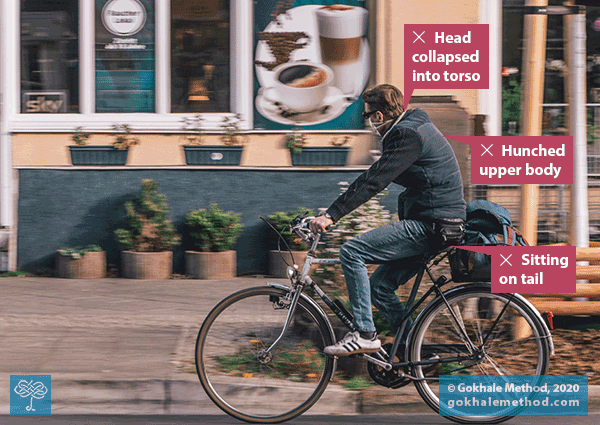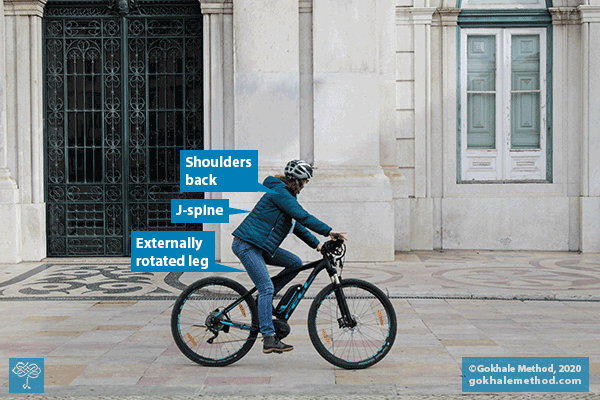How to Beat Neck and Shoulder Pain While Cycling (Cycling for Everyone, Part 2)
This is Part 2 of a 3-post series on cycling with healthy posture by Gokhale Method teacher and longtime cyclist Tiffany Mann. Read Part 1 here!

Little Tiffany (circa 5 yrs old), a new bike rider, having such fun!
Neck and/or shoulder pain is a common ailment even experienced cyclists regularly encounter. It takes awareness and muscular engagement while cycling to not allow gravity to further pull the head forward and down and round or hunch the shoulders, a posture problem that is already prevalent in our modern culture.

This cyclist in Berlin is on a bike that is too small for him, leading to the pronounced rounding visible in his upper spine. A supportive fit helps prevent rounding. Original image courtesy Raquel García on Unsplash.
While it does take some effort, via muscular engagement and kinesthetic awareness, to maintain a healthy shoulder and head placement while bicycling, the payoff is worth it. You will be able to ride pain-free for longer, and you will also be patterning a healthy upper body position regardless of your activities and movements. You will also strengthen and develop baseline tone in stabilizing muscles, and they will become more accustomed to doing the job of maintaining shoulders back, back of the neck tall and straight, and head lined up over the body, as we teach for all posture stances — sitting, standing, hip-hinging (all of which cycling incorporates!).
Opening the shoulders and chest
Rolling open the shoulders and drawing the scapulae down and back onto your back where they belong allows your chest to stay open. This gives you a better breathing pattern and better circulation to and from your arms, both of which are especially important as you are using your arms to support yourself and guide the bicycle, and using your lungs to provide oxygen to your muscles and cells that are working hard during this exercise.

This cyclist in Lisbon, Portugal rides a well-fitting, front-suspension mountain bike. Her leg is externally rotated, with a slight bend in the knee. She demonstrates a J-spine with her torso and head stacked, and hinges at the hips. Finally, her shoulders are back and her grip on the handlebars is relaxed. Original image courtesy Justine Camacho on Unsplash.
Activating the inner corset as a shock absorber
Using the set of muscles deep in your abdomen and back that we call the “inner corset” helps protect the neck along with the lower back (that other pesky trouble spot for cyclists!). Inner corset engagement gives length to the whole spine, including the cervical discs, and creates more space between the vertebrae. You will better withstand any jarring sensation from uneven road surfaces, potholes, or gravel, with this brace of deep muscles engaged. This brace of muscles includes the longus colli — deep muscles in the neck, which, when engaged, keep the neck tall and straight, and as a bonus, allow your trapezius muscles, those “hunchy” shoulder muscles, to relax.

This cyclist in Manhattan uses his well-fitting bike skillfully. His pelvis is anteverted, his shoulders remain back, and he uses his eyes to lead his gaze, rather than compensating with an arched neck — even with a baseball hat on underneath his helmet. Original image courtesy Javier de la Maza on Unsplash.
Hands, arms, and handlebars
With your inner corset in place and holding your torso steady, your arms can be relaxed when they need to be and not doing more of the work than they need to. Your hands and arms want to be relaxed and not be squeezing or holding on too tightly to the grips and handlebars — that creates unnecessary tension and fatigue.

My family on a banana seat custom tandem: Skip, Willa (4 years old), and Coco (7 years old). Original image courtesy Ken Richardson.
Lengthening the neck and employing the gaze
Craning your neck is another unhealthy posture pattern that can both fatigue the superficial muscles in the neck and damage the delicate cervical discs. Instead of craning your neck to look around you, keep the back of your neck long and tilt the head on its axis, and use your eyes — they can see plenty well and will actually benefit from the exercise of looking out into the horizon and to the periphery.

This cyclist in Vietnam demonstrates an open chest, relaxed shoulders, and healthy leg rotation while riding. Original image courtesy Minh Pham on Unsplash.
Putting it all together
All of these pieces work together to help keep your ride sustainable and pain-free. Our founder Esther Gokhale, in her two-part series on cycling posture and choosing the right bike seat for good posture, goes into great detail about ways to prevent more types of cycling-related pain through the application of Gokhale Method techniques. As Esther explains, stacksitting and hip-hinging are both crucial for sustainable cycling posture. If you need an introduction to these or other Gokhale Method techniques, keep in mind that you can get familiar with them in Esther’s book, or even work online with several of our teachers, one-on-one! Some teachers are even available for one-on-one teaching in person, where permitted. Don’t hesitate to reach out!
For more information on Tiffany’s teaching in the Boston area, contact her here.

Comments
Hi Tiffany, I can keep my
Hi Tiffany,
I can keep my shoulders back on a road bike pretty easily, but it's more difficult when riding single track on a mountain bike with a suspension fork, going over roots and rocks. It requires using my arms and legs to support my body when I'm riding over rough terrain out of the saddle. I find that I frequently protract my shoulders when riding like this and it's hard to keep them back and down while still staying strong and relaxed. I imagine my shoulders should be similar to when holding a plank position, but that's hard to do while dynamically riding a bumpy bike! Any suggestions?
Thanks!
Kevin, Durham, NC
Hi Kevin!Yes, I hear ya',
Hi Kevin!
Yes, I hear ya', mountain biking is an especially demanding style of bike riding! But also the most fun!
A strong inner corset will protect your joints from the impact and stress of the terrain, as well as provide a sturdy platform from which your limbs can more efficiently operate. Arms to hold your bike steady and steer, legs to pedal and help maintain balance. Shoulders still want to be down and back, best they are able; think about using your lats (latissimus dorsi)--these muscles retract or pull the scapula downward during a pullup (which is kind of what you are doing on a steep incline!). They will help stabilize your scapula and counter the forward pull or protracted position that gravity can pull them into. It calls on muscular endurance, but hey you're having fun while developing your strength and aerobic capacity as well! And patterning this movement in your daily life (shoulder rolls are great for this) will help it become more accessible in situations that stress and challenge your body.
Mountain biking is a very dynamic style of bike riding; finding ways to minimize fatigue (i.e., no death grip!) is important as it's easier to maintain good form when we are less fatigued. Maintaining a light grip on the handlebars/grips with your hands slightly angled out will also aid the lats by putting them in a position of mechanical advantage. This may seem counterintuitive, but squeezing harder with your hands only makes your forearms sore--you want to spread out the work to the bigger muscles groups.
I hope this helps! Keep enjoying that singletrack!
Tiffany
Thank you! This is very
Thank you! This is very helpful. The last time I rode, I had the urge to rotate my hands outward and "tuck my elbows" to protect my shoulders, so my body obviously knows what you're talking about!
Kevin
Hi Kevin,That's so cool! You
Hi Kevin,
That's so cool! You are discovering your body's wisdom; we call it primal posture, and we are all born with it! If you look at a baby, you will notice a barrel chest, a nice full ribcage, with shoulders back.
And, yes, tucking your elbows/keeping them close to your body, helps keep your scapula back home where they belong--down your back, and helps your lats do their job by putting them a place of mechanical advantage. I think you will notice too, that your breathing pattern is better too, with your shoulders rolled open and back, which is a big deal when you are demanding so much from your lungs, heart and muscles!
I love mountain biking because I can get such a great and super fun workout while training my muscles to help maintain healthy posture when off the bike too!
Thanks for this article,
Thanks for this article, Tiffany! The images are really helpful and I love seeing little you riding, and the picture of your family on the bike. I look forward to more!
Add New Comment
Login to add commment
Login